We’re continuing to discuss the art of mosaic souvenirs in this week’s blog. This week, our topic is filled with salty goodness, the memory of sandy walks, and some offbeat history. Get ready to dive into the world of Sailor’s Valentines! You may have seen examples of these antiques during a visit to a seaside museum - they tend to stand out. Constructed of hundreds of shells, these mosaic pieces boast intricate designs with a nod to the medallion styles of the time. Their geometric precision is reminiscent of classic Roman and Islamic pieces. However, they gained peak popularity in the late 18th and early 19th centuries. Making them was no small feat - requiring that the tiny shells were glued onto cotton batting in the desired patterns.
History - With a Few Twists and Turns
The legend surrounding these pieces of mosaic art was decidedly romantic: They were allegedly made by sailors for their loved ones. It’s not a huge stretch to imagine that bored men on the sea would also pass the time creating these small wonders. After all, they were already known for scrimshaw, intricate rope work, sewing, embroidery, and wood carving. Why wouldn’t a sailor, people thought, gather up seashells and make a keepsake for a sweetheart back home?
Although the name persists, it’s now known that residents of Barbados created the pieces for the tourist market - including sailors. Clues abound, including the fine woods of the frame, the inclusion of native seeds in some designs, and even scraps of Barbadian newspapers tucked behind the art.
So, in the 1800s, sailors would likely visit a place like the wonderfully-named New Curiosity Shop in Bridgetown, Barbados for their souvenirs. Yes, even sailors needed to shop! There, among the aisles of “Fancy Work”, they could find the perfect memento.
Conchylo-What?
The popularity of “curios” was fueled by a Victorian craze for shells, known as “conchylomania”. As you might guess, it was about collecting unusual sea shells and other artifacts. Like any collecting fad, it eventually faded away - but at the time, shell specimens were highly prized. The ornate mosaic art in Sailor’s Valentines was a fine addition to any wall or Cabinet of Curiosities. Inspired women were known to abandon their beloved needlework projects, and try their hand at shellwork.
It’s a logical progression. Just like quilt designs, shell mosaic projects required the use of geometry and precise placement of the pieces. Thus, the symmetry of stars and other shapes were familiar elements. However, with the soft shell colors, many pieces resembled bouquets.
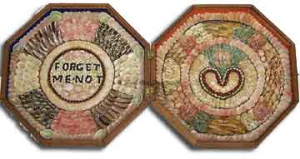
Creating Mosaic Shell Art
Looking at the process of how Sailors Valentines are made is a fun exploration. At the outset, the raw materials are quite varied and can come from many sources. Just like our mosaic tiles, the shells come from different places, each offering a unique shape or color. Our craftsmen might work with semiprecious stones from another continent as they create their medallion designs. Likewise, past and present Sailors Valentines artists use many different shells to complete each piece of art. 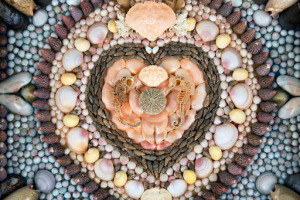 Their relatively modest size (usually under 18” wide), and framing create an intimate feeling between “Valentine” and viewer. One might not even realize that the stylized hearts, stars, or other geometric shapes are actually formed from a variety of shells.
Their relatively modest size (usually under 18” wide), and framing create an intimate feeling between “Valentine” and viewer. One might not even realize that the stylized hearts, stars, or other geometric shapes are actually formed from a variety of shells. 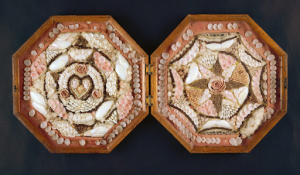 But, as one moves closer, the details are splendid. Rounded snail shells, pointed whelks, and more create the shapes. Identical clusters of shells have been shaped into diamond, triangular, semi-circular, and floral sections.
But, as one moves closer, the details are splendid. Rounded snail shells, pointed whelks, and more create the shapes. Identical clusters of shells have been shaped into diamond, triangular, semi-circular, and floral sections. 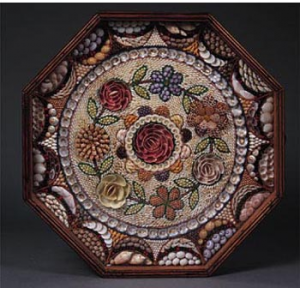
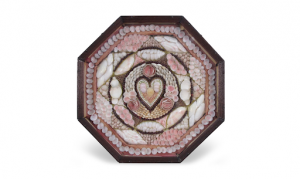 Here’s a modern version - they’re still a popular form of art!
Here’s a modern version - they’re still a popular form of art! 
 Floral shapes are still particularly prized by collectors, as are designs featuring romantic sayings (Much like our customized mosaic wall art designs!)
Floral shapes are still particularly prized by collectors, as are designs featuring romantic sayings (Much like our customized mosaic wall art designs!)
Getting the look today
Boho and Coastal Style interior design styles are perfect for Sailors Valentines displays. They have a built-in beachy vibe and loads of visual interest. At the same time, their shapes and symmetrical design are like the classic medallion shapes designers love.
Unlike fragile originals, mosaic art designs can be used anywhere! Inside on walls and floors - outside in pools and spas - mosaic tile is tough, weather-resistant, and won’t fade. If you love the look of these sea-themed collectibles, you’ll like to explore some of our nautically-themed designs like our Pearly Shell Marble Mosaic.
Just like some of the original art shown above, this medallion has strong symmetry and sea creatures. However, there’s no need to put it behind glass and hang it safely on your wall. Instead, it has been used as a shower floor, where it cleverly centers the drain in the design! Slip-proof and easy to care for, our mosaic art is gorgeous underfoot, as well!
Similar hues can be found in our elegant Oceanus Medallion.
Also underfoot, this sea turtle welcomes guests. Look closely for a great design idea: The round shape has been inset into the plank flooring! This creates an appealing contrast, a cool focal point, and can serve as a subtle reminder of which way the traffic should move. Worried about finding North? Our turtle companion can always swim in the correct direction!
A less subtle reminder of the compass points, our Basila Mosaic Medallion can be set into your floors and calibrated to your exact position! This entry space has a wonderful ambiance that ties into local landscapes and nature. It fits perfectly into this soothing interior with plenty of natural wood, beach stone, and ocean hues. 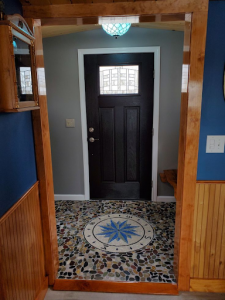 Have you ever run across a vintage Sailors Valentine in your travels? Drop a photo in the comments - we’d love to see your examples!
Have you ever run across a vintage Sailors Valentine in your travels? Drop a photo in the comments - we’d love to see your examples!
Start your shopping adventure in our online catalog – and be sure to sign up for our newsletter to stay up to date on our latest news, interior design tips, and more.
PREVIOUS POST
How To Clean, Cover And Prevent Wall And Ceiling Stains In Your Home
NEXT POST
How Tile Mosaics Can Transform Your Bathroom
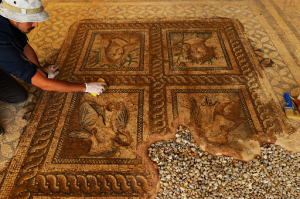 Image Source Pinterest
Image Source Pinterest
 Image Source Wikipedia
Image Source Wikipedia
 Image source Bowers Museum
Image source Bowers Museum
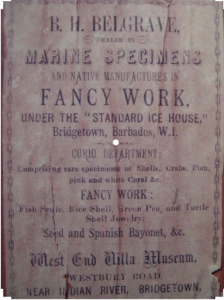 Image source Bowers Museum
Image source Bowers Museum
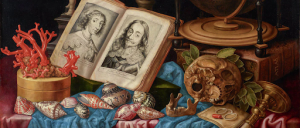 Image Source Pinterest
Image Source Pinterest

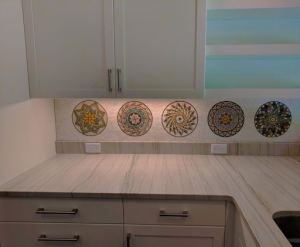 Image Source Mozaico
Image Source Mozaico
 Their relatively modest size (usually under 18” wide), and framing create an intimate feeling between “Valentine” and viewer. One might not even realize that the stylized hearts, stars, or other geometric shapes are actually formed from a variety of shells.
Their relatively modest size (usually under 18” wide), and framing create an intimate feeling between “Valentine” and viewer. One might not even realize that the stylized hearts, stars, or other geometric shapes are actually formed from a variety of shells.  But, as one moves closer, the details are splendid. Rounded snail shells, pointed whelks, and more create the shapes. Identical clusters of shells have been shaped into diamond, triangular, semi-circular, and floral sections.
But, as one moves closer, the details are splendid. Rounded snail shells, pointed whelks, and more create the shapes. Identical clusters of shells have been shaped into diamond, triangular, semi-circular, and floral sections. 
 Here’s a modern version - they’re still a popular form of art!
Here’s a modern version - they’re still a popular form of art! 
 Floral shapes are still particularly prized by collectors, as are designs featuring romantic sayings (Much like our customized mosaic wall art designs!)
Floral shapes are still particularly prized by collectors, as are designs featuring romantic sayings (Much like our customized mosaic wall art designs!)
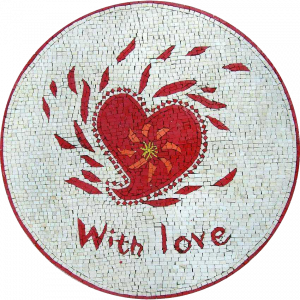 Image Source Mozaico
Image Source Mozaico
 Image Source Pinterest
Image Source Pinterest
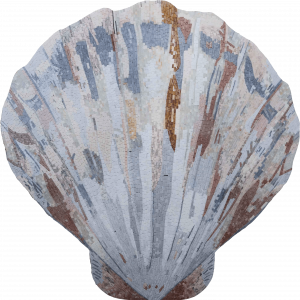 Image Source Mozaico
Image Source Mozaico
 Image Source Mozaico
Image Source Mozaico
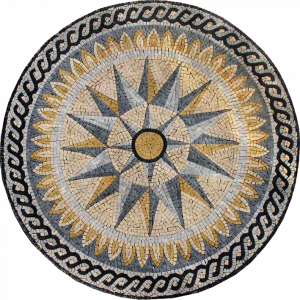 Image Source Mozaico
Image Source Mozaico
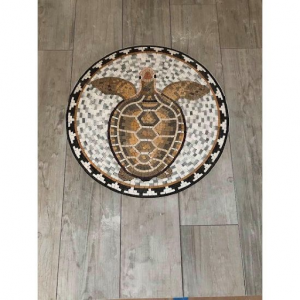 Image Source Mozaico
Image Source Mozaico
 Have you ever run across a vintage Sailors Valentine in your travels? Drop a photo in the comments - we’d love to see your examples!
Have you ever run across a vintage Sailors Valentine in your travels? Drop a photo in the comments - we’d love to see your examples!
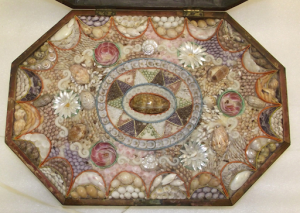 Image Source Pinterest
Image Source Pinterest


2 commentaires
Hello Danielle, you can find any type, size and theme of mosaics at Mozaico, even customize your own!
So can I find any of the small mosaics at your store or are they just historical mosaics ?